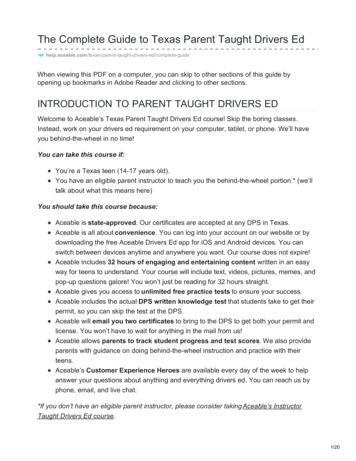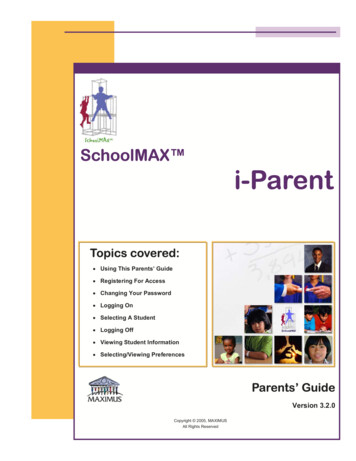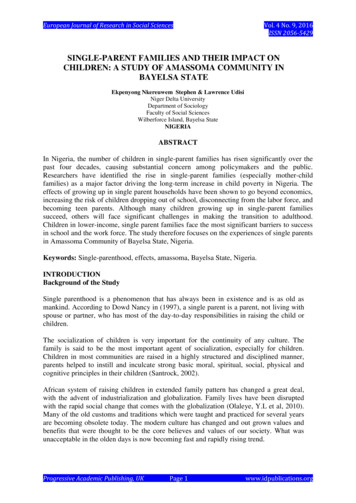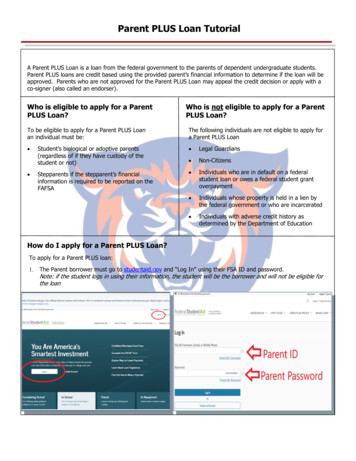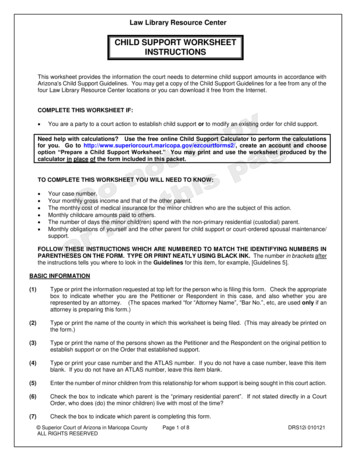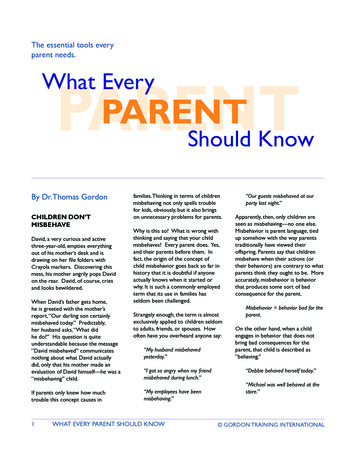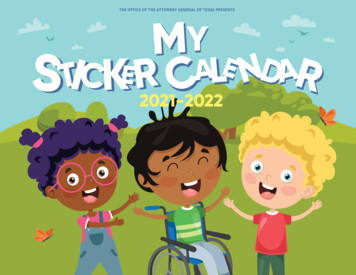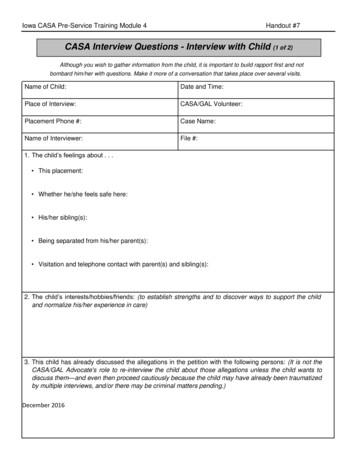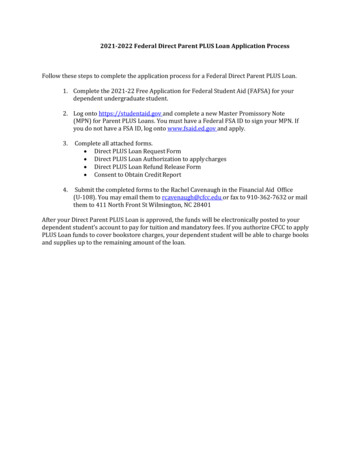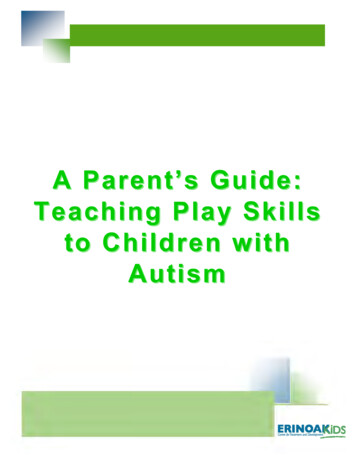
Transcription
A Parent’s Guide:Teaching Play S killsto Children withAutism
Table of Contents1. Introduction .32. Levels of Socialization in Play .Solitary Play .Parallel Play .Associative Play .Cooperative Play .446893. Playdates .What are Playdates .Structuring a Playdate .Preparing Peers for Playdates .Monitoring Progress .Playdate Observation Form .1313151722234. Playbooks and Play Scripts .265Teaching Ball Play .305. Pretend Play .326. Social Games .347. Independent Activity Schedules .378. References .43Copyright ErinoakKids Centre for Treatment and Development. 2012. All Rights Reserved.This Autism Spectrum Disorders resource is provided for informational purposes only and is not a substitute for professional advice, diagnosis ortreatment, from a qualified health-care provider.CW-Autism Services 20122
Play Skills: Introduction“You can discover more about a person in an hour of play than ina year of conversation.” PlatoFor most children, play is a naturally occurring phenomenon that promotes their engagement andlearning, independent performance and social inclusion. Play is the foundation of learning tosocialize with others. Typically play happens, voluntarily, often spontaneously, and offers internalreinforcement and rewards. In contrast, play of individuals with Autism Spectrum Disorder (ASD)is characterized by impairments in reciprocal social, communication, and restricted and repetitivestereotyped patterns of behaviour. This play lacks qualities of diversity, flexibility, and creativityand can occur without social engagement. Therefore, without specific guidance, children withASD are less likely to engage in functionally appropriate play. Research has shown that play mayhelp develop cognitive, social, linguistic, and emotional development.This resource is based on evidence-based practices and looks at strategies that can be used toteach your child with a diagnosis of ASD how to begin play. This teaches the basis of how to playindependently and ultimately socialize with their peers. The following strategies lay out asystematic and structured way of teaching play skills.Copyright ErinoakKids Centre for Treatment and Development. 2012. All Rights Reserved.This Autism Spectrum Disorders resource is provided for informational purposes only and is not a substitute for professional advice, diagnosis ortreatment, from a qualified health-care provider.CW-Autism Services 20123
Levels of Socialization in Play: Solitary PlayWhat is Solitary Play?When looking at levels of socialization in play, Solitary Play (when a child plays by him/herself), is typicallythe first level. In solitary play, the child manipulates objects on their own. Learning to play byhimself/herself allows for: increased independence during free time.the development of alternative behaviours to engaging in stereotypical behavior (for example pushinga car on a racetrack instead of shaking the car up and down in front of their eyes).replacement behaviours for automatic reinforcement.a way for interacting socially with peers.How can I prepare my child for Solitary Play? Toy manipulation One-step toy manipulation Two-step toy manipulationToy manipulation:The goal of toy manipulation is to teach your child to imitate actions with toys. This is the basis to teachyour child the functions of how to use objects and play with toys functionally. Imitation skills are the buildingblocks of observational learning and are essential for more complex play and may improve imitative skills.How to teach one-step toy manipulation:Begin by teaching your child to imitate one action, for example, putting a single puzzle piece in an insetpuzzle, putting a peg in a peg board, placing a shape in a shape sorter, or rolling a car. Remember toprovide positive reinforcement to your child when he/she is engaging in the activity. Also use appropriateprompts, and gradually fade prompts so your child is engaging in the activity independently. Furthermore,teach different actions for each toy to expand his/her play skills with different toys (rolling a car, flipping acar).How to teach two-step toy manipulation:When your child develops one-step manipulation with toys, you can work on teaching your child two-stepsequences of actions. For example, put a doll in the car then roll the car or bottle to doll’s mouth then dollto bed.Additional examples of toy manipulation ideas:One-stepBang toy hammerStuffed toy jumpingBrush doll’s hairRoll ballBang tambourineTwo-stepBottle to doll’s mouth, put doll to bedRoll ball, bounce ballPress buttons on phone, phone to earAnimal figurine walking, feeding animal figurinePut spoon in a bowl, stirring the spoon in the bowlCopyright ErinoakKids Centre for Treatment and Development. 2012. All Rights Reserved.This Autism Spectrum Disorders resource is provided for informational purposes only and is not a substitute for professional advice, diagnosis ortreatment, from a qualified health-care provider.CW-Autism Services 20124
Levels of Socialization in Play: Solitary PlayCommon Difficulties: Your child might memorize the action, so it is important to teach more than one action for each toy Automatic reinforcement behaviours may occur, for example, hand flapping or scripting which interferewith the play activity should be redirected Your child may not enjoy playing with certain toys, despite the adequate amount of reinforcement andprompting given. You might have to switch to toys that may interest him/her more.Teaching Independent Play Activities:Children with autism may not pick up on social cues that are required to play a game with their peers orhow to play with a toy in the way it was intended. Teaching a child with autism how to play independentlymay require more structured planning for him/her to acquire the appropriate play behavior.To teach your child how to learn to play with a new toy independently, please consider the following: Select a toy that matches their skill level (For example, peg board, shape sorter, puzzle). Keep it simple. If your child finds it difficult he/she may not be motivated to play. Choose a toy based on your child’s interests (for example, Thomas the Train, Dora, etc.). Provide a model to show your child how to use the toy appropriately. You can model it or use asibling or a friend. Provide the appropriate prompt level for your child to be successful using the toy (for example,providing a hand over hand prompt to put the puzzle pieces together). Fade your prompts as yourchild engages more independently with the toy. Remember to reinforce your child for using the toy appropriately (for example, providing your childwith an edible reward and/or social praise so your child sees play as a positive experience).Initially keep the play time short and increase the time as your child becomes more motivated to play.Always end your child’s independent play time on a positive note to encourage future play.Copyright ErinoakKids Centre for Treatment and Development. 2012. All Rights Reserved.This Autism Spectrum Disorders resource is provided for informational purposes only and is not a substitute for professional advice, diagnosis ortreatment, from a qualified health-care provider.CW-Autism Services 20125
Levelsin Play: Parallel PlayLevels of Socialization in Play: Parallel Playof SocializationWhat is Parallel Play?Parallel Play is described as two children sitting near or beside each other while playing with similar objects(for example, playing with blocks, colouring, play dough, sand and water play). Parallel Play teaches yourchild to share space with another child while engaging in solitary play. This progresses to socialawareness of other children and leads to interactions with one another which can result in an increase inlength and complexity of play (for example, imitating peers and learning rules of play).How can I prepare my child to be able to engage in Parallel Play with other children?Teaching your child to engage in Solitary Play and therefore playing functionally with toys would be the firststep (for example, rolling cars or stacking rings). In the table below, there are examples of activities youcan use to teach your child to play on their own (Solitary Play). When your child has several activities, youcan use these as your basis for Parallel Play.Activities to prepare your child for Parallel Play Colouring Painting Water and sand play Blocks Play dough Beadwork PuzzlesHow can I support my child’s development at this stage?Parallel Play with an a adultBy teaching your child these skills and expanding his/her repertoire of toys and activities, you yourself areengaging in Parallel Play with your child. A good way to start this is to sit at a table or on the floor with yourchild. Select an activity or toy to teach your child, for example colouring. Have two sets of materials (onefor you and one for your child). Begin colouring the paper and observe if your child will engage in theactivity. If your child does not engage, you can give a verbal prompt to “colour” and point to the crayon. Asmuch as possible, use physical or gestural prompts to engage your child in the activity. Try to avoid usingverbal prompts as they are the most difficult prompts to fade. When your child begins to colour, reinforcehim/her by giving praise and a tangible reward (for example, candy) if needed.Parallel Play with another childTeaching your child how to play functionally with various toys and activities prepares them for playing withanother child. A beginning strategy you can use is to set out toys and/or activities that are highlymotivating for both children. Also, keep in mind how to set up the environment to promote closer proximitybetween the children. Use small carpets and table tops to encourage closer proximity. Using a water andsand table, setting blocks on a small carpet, or having arts and crafts materials on a table are examples ofactivitiesCopyright ErinoakKids Centre for Treatment and Development. 2012. All Rights Reserved.This Autism Spectrum Disorders resource is provided for informational purposes only and is not a substitute for professional advice, diagnosis ortreatment, from a qualified health-care provider.CW-Autism Services 20126
Levels of Socialization in Play: Parallel PlayWhen you are teaching your child Parallel Play, also consider how close your child can tolerate being toanother child. Initially the children may be far apart, but gradually move them closer together andremember to provide reinforcement (for example, social praise “good job” with a tangible reward [piece ofcandy]). Also select a peer that would be cooperative and would be a good model for your child.Remember to reinforce both children when they are engaged in Parallel Play!Copyright ErinoakKids Centre for Treatment and Development. 2012. All Rights Reserved.This Autism Spectrum Disorders resource is provided for informational purposes only and is not a substitute for professional advice, diagnosis ortreatment, from a qualified health-care provider.CW-Autism Services 20127
Levels of Socialization in Play: Associative PlayWhat is Associative Play?In this stage of play, children interact with other children by giving, taking and sharing play materials. Intypically developing children, this usually starts at around three years of age. In this stage your childbegins to engage in activities in which a group of children participate in similar or identical activities withoutformal organization, group direction, group interaction, or a definite goal. The children may borrow or lendtoys or pieces of play equipment, and they may imitate others in the group, but each child actsindependently, as on a playground or among a group riding tricycles or bicycles. An example of this maybe when a group of children are playing with a set of building blocks and they’re all sharing the blocks butbuilding their own towers. Social interaction at this stage is minimal between peers.How can I support my child’s development at this stage?You can help your child with ASD learn skills for Associative Play by encouraging him/her to take turns ortrade items while still playing on his/her own – for example, trading dolls and doll clothing, trains or cars,tricycles and scooters etc. with other children. When you play with your child, teach and practice turntaking behaviour. Turn-taking games will promote communication. When teaching this skill to your child,begin by being in close proximity so you can prompt and reinforce your child through the task to promoteturn-taking. Initially, you may need to physically prompt your child through all the movements involved andreinforce him/her when a willingness to follow through is demonstrated. Begin teaching turn-taking with anitem that your child has some interest in to increase his/her motivation to participate. For example, if yourchild enjoys playing with a toy car you may want to teach him/her to take turns passing it back and forth.You may also use an additional person such as a sibling, peer or other adult while you prompt your childfrom behind. This may take the form of: Either you or another person sits on the floor across and in close proximity to your child.Count “1, 2, 3” and either you or the other person push the toy car to your child making sure itreaches them.If you’re the only one teaching this activity to your child, place your child’s hands on the toy car andprovide a hand over hand prompt (physical prompt).Count “1, 2, 3” and while prompting, have your child push the toy car back toward you. If you havean additional person, prompt your child from behind.Reinforce your child for pushing the toy car back to you and taking a turn.Remember to fade the level of prompts needed as your child demonstrates this skill successfully. Increasethe number of turns in the sequence with each practice and have your child engage in the turn taking indifferent environments with a variety of peers to promote generalization of the skill. Some other examplesfor teaching this skill could be sharing a musical instrument such as the drums, taking turns writing on achalkboard, or using a computer program.Copyright ErinoakKids Centre for Treatment and Development. 2012. All Rights Reserved.This Autism Spectrum Disorders resource is provided for informational purposes only and is not a substitute for professional advice, diagnosis ortreatment, from a qualified health-care provider.CW-Autism Services 20128
Levels of Socialization in Play: Cooperative PlayWhat is Cooperative Play?Cooperative Play takes place between two or more children as they grow and develop socially andemotionally. In Cooperative Play, children exchange ideas about the game or the toy they are playing withat that moment in time. Rules tend to still be very loosely constructed, but children know who is playingwhich role in their game. Play may last only a few minutes or it may stretch out for longer periods of time.Gradually they learn to respect the property rights of others. This is a clue that they are gaining socialskills; at this same time they begin to understand that they need permission to play with certain materialsand certain people. They are also more willing to share their toys for the sake of the game. Communicationabout the play is the critical point of Cooperative Play.Cooperative play can take place almost anywhere — outside on the playground or downstairs in thebasement. In any environment, children learn from watching other children play and interacting with themsociallyWhat are some considerations to promote successful interaction with his/her peers? a positive environment. Model and encourage polite, respectful behavior toward others. Rewardsocial skills such as helping others, giving and accepting praise, compromise, etc.the number of children who will play together – you may wish to start off with just 2 and then workup to a larger number of children in your group.how long the groups will work together. You may start off by working/playing for 2 minutes andextend the time as children tolerate being around each other for longer.present and clearly explain the activity to your child.What are some activities I can use to encourage Cooperative Play with my child?The fact that learning to cooperate is essential doesn't mean that it's easy. Getting children to share andplay together can be tricky. Parents and teachers know that the key is to set up activities that give eachchild a distinct role while also requiring kids to help one another. Here are some examples of activities thatmay help guide some Cooperative Play:Side by side Science:Simple experiments can be great opportunities for kids to explore the world together and share ideas. Test things out: Using household items, children can investigate what floats and what sinks, whatis transparent and opaque, what is light and what is heavy, or how many rocks weigh the same asone toy truck. One child can be the "recorder," keeping track of the experiment, while the otherplaces objects in water, on a scale, or holds them up to the light. As children work together,encourage a dialogue between them. A give and take of ideas, with each child sharing his/herunique interpretation of the results of the experiments, will enrich the experience for everyone. Stimulate the sense: Give children items that have distinctive odors, such as lemon, vanilla,cinnamon, onion, garlic, and licorice. Put each item on a small plastic lid and encourage thechildren (with their eyes closed) to take turns smelling and identifying them. Ask how these differentCopyright ErinoakKids Centre for Treatment and Development. 2012. All Rights Reserved.This Autism Spectrum Disorders resource is provided for informational purposes only and is not a substitute for professional advice, diagnosis ortreatment, from a qualified health-care provider.CW-Autism Services 20129
Levels of Socialization in Play: Cooperative Play foods and spices smell. Are these smells familiar from the food they eat? Point out what is differentand the same in each child's take on the smells. As they describe the smells and their experienceswith them, children will see that they each have a distinct perspective to contribute, all of which addto a full comparison of the smells. (You can also try the activity with objects of different textures,different shapes and colors, and those that make different sounds.) Create a garden: Block out part of your yard for an area where children can plant flowers andvegetables. Let your kids and their friends work together to make a drawing of the garden they'dlike to create. As they plan and then work on their garden, point out how they're all contributing.Encourage them to take on different jobs, such as planting, monitoring, and watering. This projectrequires all of the little gardeners to share ideas and tasks: The bounty the garden bears will trulybe the product of everyone's labor.OutdoorHere are some ways kids can exercise their ability to cooperate as they build large-motor skills. Car wash: One child can run the car wash and ask what kind of service the customers want fortheir bike or wagon. Another child can be the ticket or money taker. A third can wash the vehicleswith a cloth or big sponges and a pail of water. The kids can work together to create car wash signsand tickets in advance. Encourage children to take turns playing the different roles. Construction site: As children play in the yard or sandbox with trucks, pails, and shovels, theycan deliver the sand or dirt, pretending they are preparing a construction site. Each child can be adifferent kind of worker (such as steam shovel operator, trench digger, or truck driver). Encouragethe little builders to take turns using different vehicles as they work on the project and collaborateon building something. Relay races: Kids can write or draw a secret message and then work together to get it from oneplace to another. Help them set up a relay race course through the yard or park. Each child canstand in a designated spot and then run with the message from one spot to the next, passing italong to the next child. Point out that each runner helped to deliver the secret message. (Works wellwith tricycles too!)ArtCreating works of art is a wonderful way to promote cooperation while helping children develop theircreative-thinking and fine-motor skills. Table paint: Tape a large sheet of paper over a low table and let two or more children finger paintall over the paper. They'll love squishing their fingers and hands through the paint — and they'lleach help to create a unique painting.Make a mural: Post a long sheet of paper on the wall and let children decide what the topic of themural will be (a forest with animals, an ocean with all kinds of boats and fish, a neighborhood).Then they can each select items to draw and can choose a medium (markers, crayons, posterpaint, water colors) with which to create the mural. When they're done, ask the children to describehow they each helped to make the mural. Copyright ErinoakKids Centre for Treatment and Development. 2012. All Rights Reserved.This Autism Spectrum Disorders resource is provided for informational purposes only and is not a substitute for professional advice, diagnosis ortreatment, from a qualified health-care provider.CW-Autism Services 201210
Levels of Socialization in Play: Cooperative Play Buddy tracings: On a large sheet of paper, have one child trace another as he lies down andstretches out his arms. After the tracing is finished, both can work together to fill in the details. Thenthe child who was traced can outline his partner. Display the tracings together, and point out thatthe kids couldn't have made them without each other. Build something: Using play dough or clay, children can collaborate on making a zoo, a pet shop,a bakery, a house, or a toyshop. Encourage them to help each other create the animals and objectsthat they want in their setting. Ask the kids to describe how they each contributed to the project.ActingResearch shows that children develop important skills through pretend play. In restaurant play, forexample, kids increase their vocabulary as they learn words such as "menu," "waitress," and "bill." Theylearn to be flexible, substituting objects for those they do not have on hand, and to sequence and putevents in order (you can't serve the food until you cook it). And, most importantly, when children areinvolved in dramatic play, they're strengthening their social skills and learning to share, take turns, andcooperate. Prop up play: Give your children and their playmates somesimple props to use in dramatic play: empty food containers;wooden spoons; pots and pans; paper plates; old clothes andshoes; hats; index cards and markers; and old phones andtypewriters. These items can spark kids' imaginations and spurthem to share ideas for collaborative dramatizations. Start a business: Encourage children to set up a pretend store,zoo, restaurant, or other establishment. Help them think of andcreate the materials they'll need. Children can decide who willbe in their place and what role each of them will take. Point outhow many different people need to pitch in and help out to make this business work. Dramatize stories: Bringing favorite tales to life is a sure-fire way to engage a group ofyoungsters. Let them pick a story and then create props, take on different roles, and act out theaction. Working together, they'll be able to recreate their beloved story.Toys to shareNot all toys lend themselves to cooperative play — some are simply best forindependent play. When your child is having friends over or playing with asibling, it's best to provide toys and games that work well with small groups.Try putting out these playthings, all of which are easy to share:Copyright ErinoakKids Centre for Treatment and Development. 2012. All Rights Reserved.This Autism Spectrum Disorders resource is provided for informational purposes only and is not a substitute for professional advice, diagnosis ortreatment, from a qualified health-care provider.CW-Autism Services 201211
Levels of Socialization in Play: Cooperative Play Musical instruments: From maracas to tambourines, using instruments together allows childrento make music they couldn't create on their own. When kids form a band, they hear the power ofcollaborating. Cards: Playing basic card games and learning to follow simple rules is a big step towardcooperation for youngsters. At around the age of 4, children are able to put aside what they want todo and abide by the group's rules.Puppets, dolls, and stuffed animals: Playmates can bring inanimate pals to life and act out talesand adventures with more than one character.Children's books: Kids love sharing cherished stories. Encourage them to each take on adifferent character's voice and make the sounds described in the story as they read or retell the taletogether.Puzzles: Putting all the pieces in place is easier — and more enjoyable — when little problemsolvers put their heads together.Figures, cars, and blocks: By building with blocks, adding figures, cars, road signs, and the like,children learn from one another's ideas and see how the power of group play can add fun.Dress-up clothes: Old hats, bags, shoes, and shirts are perfect props for letting children shareimaginative ideas and transform themselves into an infinite roster of roles. Copyright ErinoakKids Centre for Treatment and Development. 2012. All Rights Reserved.This Autism Spectrum Disorders resource is provided for informational purposes only and is not a substitute for professional advice, diagnosis ortreatment, from a qualified health-care provider.CW-Autism Services 201212
Playskills: PlaydatesWhat are Playdates and why are they important?Playdates are scheduled time periods for your child to interact with another child in both structured andunstructured activities. Your child’s ability to engage in play with other children teaches problem-solvingskills, enables him/her to practice imaginative play, and helps develop his/her sense of humor. All of theseskills are crucial in improving the ability of children with autism to think abstractly and understand how tosucceed in a natural environment. Children with autism may not be able to generalize skills acrossenvironments and people, which means even when they’ve mastered a specific skill in one setting with oneperson they may not be able to demonstrate the same skill in another setting with another person.Playdates provide your child the appropriate experience to generalize his/her skills with different peers and ina variety of environments as well as develop friendships and have fun!How can I prepare my child to be able to engage in a Playdate?Before your child is ready for formal Playdates it is essential that you involve him/her with his/her peerseven if he/she doesn’t have independent play skills. Just having your child learning to tolerate being inclose proximity to others is supportive in moving toward developing play skills. Public areas such asplaygrounds, pools, and indoor gymnasiums are places that you can utilize where your child can engage inmotor movements that require minimal social interactions with peers. You may need to expose your childrepeatedly to these environments for longer periods of time for him/her to become increasinglycomfortable. Consider these activities as they may be less stressful to your child than being in a one toone situation with increased social demands that occur during a Playdate. Teaching your child how tomove from one activity to another in a variety of settings is an important and essential skill to preparehim/her for the many transitions that can occur within a Playdate. (For example, try moving from locationto location within your house, or other settings going from toy to toy or activity to activity. You can provideyour child with the appropriate prompts and reinforcement to increase his/her success in this area. Thiswill support smooth transitions when it is time for him/her to engage in Playdates with a peer.What are some of the skills required to promote successful social interactions with peers?You can teach your child to: Be able to request items from adults and peers. Be able to make his/her requests known. Tolerate being in close proximity to other children. Play with several toys in the manner in which they’re intended. Play with sensory materials (e.g., play dough, sand and water). Be able to use manipulatives (e.g., blocks, rubber stamps, crayons). Be familiar with a social game (e.g., Tag, hide and seek). Sing and/or act out some songs (e.g., “Old MacDonald”, “If you’re happy and you know it”). Play a simple game (e.g., Candyland, Chutes and ladders). Engage in outdoor play (e.g., play on playground equipment, wade in a swimming pool). Engage in pretend play (e.g., dress up like a cowboy, robot, favourite cartoon character).Copyright ErinoakKids Centre for Treatment and Development. 2012. All Rights Reserved.This Autism Spectrum Disorders resource is provided for informational purposes only and is not a substitute for professional advice, diagnosis ortreatment, from a qualified health-care provider.CW-Autism Services 201213
Playski
The goal of toy manipulation is to teach your child to imitate actions with toys. This is the basis to teach your child the functions of how to use objects and play with toys functionally. Imitation skills are the building blocks of observational learning and are essential for more complex play and may improve imitative skills.
